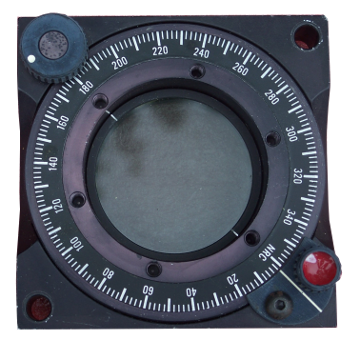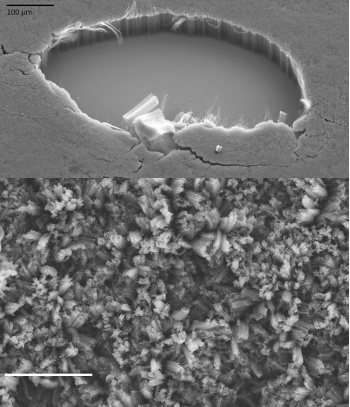Ultra-Hyper-Super Black
November 4, 2019
Scientists secretly write
superlatives into the
scientific literature through use of
metric prefixes. It isn't just
technology, it's
nanotechnology; and, it isn't just
computing, it's
exascale computing. That's easy to do, since
physical quantities are involved - the
meter in the first case, and
floating point operations per second in the later.
Things move from the
scientific to the
advertising realm when we express
qualities, such as
flavor, rather than quantities. In that case, the
Mad Men use
intensifier words like
super (from the
Latin adverb,
super, above),
ultra (from the Latin adverb,
ultra, beyond) and
hyper (from the
Greek prefix,
῾υπερ, over/beyond).
Colors are particularly hard to describe, and that leads to expressions such as
snow white and
black as
night. One look in the
paint section of your local
home goods store demonstrates the colorful names
invented for different shades of white. As for black, some nights are blacker than others, and some black paints
reflect less light than others. Many technologies are aided by black
coatings that
absorb, rather than reflect, light. One example of this is the black coating used for
fixtures that hold
lenses,
filters,
mirrors, and other
optical components, on
laboratory optical tables (see photograph).

An older model of a Newport Corporation manual rotary optical tables fixture with inserted polarizing filter.
This fixture is 3-1/2 inches square, and it was used in experiments on magneto-optical garnets.
The black coating prevents stray light reflections from causing errors in sensitive optical experiments.
(Photo by the author, also posted at Wikimedia Commons. Click for larger image.)
Aluminum is a convenient
material for making small
mechanical components, such as the optical fixture shown above. It's fortunate that there's an easy way to coat aluminum in a durable black layer; namely,
anodization. In anodization, the aluminum piece is used as the
anode (
positive electrode) in an
electrochemical cell where it's opposed by a
cathode (
negative electrode, usually
lead) in a
dilute sulfuric acid solution. Application of a
current of a few tens of
milliamps per
square inch produces an
aluminum oxide layer a few
micrometers thick on the piece through migration of the
anion in the
electrolyte,
oxygen in this case, to the aluminum anode.
The aluminum oxide layer produced by anodization is
porous with pore size of the order of about 50
nanometers. The pores enable growth of a thick oxide layer, since a uniform oxide would be
insulating. The pores can also be
infiltrated with
dye, and this allows the bright coloring of things such as
carabiner,
keychains, and cases for
electronic devices. One dye color can be black, so black anodization followed by a process to give the surface a
matte finish for
diffuse reflection will give a good optical black on an aluminum piece.
When
physicists in the
19th century needed to blacken an object for creation of a
black body, they would form layers of
soot on
glass. Soot is prepared by
condensing from the
smoke from the incomplete
combustion of
hydrocarbons, as from a
candle. Soot deposited carefully in this manner will
reflect less than 1% of
visible light, making the glass slide 99% black.
Soot is
carbon, and when
carbon nanotubes were discovered an obvious early experiment was to determine the blackness of carbon nanotube
Arrays. Early experiments demonstrated that the multitude of holes and gaps in
vertically-aligned carbon nanotubes arrays trap light by forcing
light rays to make many multiple reflections to exit the material. As a result, more than 99.955% of incident light is
absorbed at
visible wavelengths.[1]
Science is a
competition, so this initial result in 2008 started a race for blacker, and blacker, layers. The next year, another
research group created a similar array of
single-walled carbon nanotubes and found the material to be an extremely broadband
black body from 0.2 - 200 μm.[2] The researchers
theorized that this enhanced blackness arose from the sparseness and imperfect
alignment of the vertical single-walled carbon nanotubes.[2] Single-walled carbon nanotubes seem to be preferable, since a
NASA showed that arrays of vertically-aligned
multi-walled carbon nanotubes absorb only 99.5% of visible and
ultraviolet light, and just 98% of far-
infrared light (see figure).

An array of vertically-aligned multi-walled carbon nanotubes created as an optical absorber and emitter by NASA.
The upper image has a portion removed to show the vertical alignment of the nanotubes, and the lower image shows the surface at high resolution. The scale bar is a 50 micrometer marker.
This material absorbs 99.5% of visible and ultraviolet light, but only 98% of far-infrared light. NASA is concerned not only with the optical absorption property, but with the complementary emissivity. Such black body materials will efficiently radiate heat energy to keep spacecraft sensors and electronic components cool.[5]
(Images by Stephanie Getty, NASA Goddard Space Flight Center)
In the race to blacker black, scientists from
Shanghai Jiao Tong University (Shanghai, China) and the
Massachusetts Institute of Technology (Cambridge, Massachusetts) have developed a vertically aligned carbon nanotubes material that's an
order of magnitude blacker than previous materials. The nanotubes are grown on
chlorine-
etched aluminum foil, so the process is capable of producing
commercially viable sheets of large
area. Their foil material absorbs about 99.995% of incident light over a wide range of wavelengths.[4-5]
This research team had been investigating the growth of carbon nanotubes on aluminum for their
electrical and
thermal conductivity properties.[5] In their process, chlorine is used to strip the native oxide from the aluminum to provide a proper surface for nanotube growth.[5-6] Says
paper author,
Kehang Cui, formerly with MIT and now a
professor at Shanghai Jiao Tong University, "This etching process is common for many
metals... For instance,
ships suffer from
corrosion of chlorine-based
ocean water. Now we’re using this process to our advantage."[5] The aluminum is first soaked in
salt water, transferred to an oxygen-free
environment to prevent
reoxidation, and carbon nanotubes are then deposited by
chemical vapor deposition.[5] The process occurs at the very low
temperature of 100
°C.[5]
The researchers were principally interested in the material's electrical and thermal properties, and they found a 5-fold decrease in
interfacial electrical resistance and a 66% increase in
specific surface area as compared with nanotube layers grown without the chlorine process.[4] But they also noticed that their layers were especially black. Says Cui, "I remember noticing how black it was before growing carbon nanotubes on it, and then after growth, it looked even darker... So I thought I should measure the optical reflectance of the sample."[5]
The nanotube surface absorbed at least 99.995% of incoming light from every
angle.[5] That means that the aluminum foil substrate can have bends and kinks and still be completely black.[5] This blackness might be helped by the fact that the etched aluminum on which the nanotubes are grown is black at the start.[5] Says co-author,
Brian Wardle of MIT, "CNT
forests of different varieties are known to be extremely black, but there is a lack of mechanistic understanding as to why this material is the blackest. That needs further study."[5]

Reflectance of the MIT ultrablack material as a function of wavelength compared with the previous blackest material.
The red line is a moving average to smooth the data.
(Created using Inkscape from data in ref. 4.[4] Click for larger image.)
There has been an
historical link between technology and
art, as in the rapid
development of
video technology for
entertainment, so it might not be surprising that this carbon nanotube black has already been used in art.
Diemut Strebe, an MIT
artist-in-residence, created a
work of art entitled, "
The Redemption of Vanity," in
collaboration with the nanotube research team. This was a 16.78-
carat natural yellow diamond coated with the ultrablack carbon nanotube material and exhibited at the
New York Stock Exchange.[5] While there's a
pending patent on the ultrablack material, the
inventors have allowed a free
license for
noncommercial art projects.[5]
One practical application would be as an
anti-glare coating for such things as
space telescopes.[5] It would be a useful material for a
star shade, the light
shield that blocks a
star's illuminance to allow the search for
exoplanets.[5] The
robustness of this aluminum backed material is important, since such a shade would need to survive being
rocketed into
space.[5]
In looking to the
future, Wardle notes that "Our material is 10 times blacker than anything that’s ever been reported, but I think the blackest black is a constantly moving target. Someone will find a blacker material, and eventually we'll understand all the underlying mechanisms, and will be able to properly engineer the ultimate black."[5]
References:
- Zu-Po Yang, Lijie Ci, James A. Bur, Shawn-Yu Lin and Pulickel M. Ajayan, "Experimental Observation of an Extremely Dark Material Made By a Low-Density Nanotube Array," Nano Lett., vol. 8, no. 2 (February, 2008), pp 446-451.
- Kohei Mizuno, Juntaro Ishii, Hideo Kishida, Yuhei Hayamizu, Satoshi Yasuda, Don N. Futaba, Motoo Yumura and Kenji Hata, "A black body absorber from vertically aligned single-walled carbon nanotubes," Proc. Natl. Acad. Sci., vol. 106, no. 15 (April 14, 2009), pp. 6044-6047.
- Lori Keesey and Ed Campion, "NASA Develops Super-Black Material That Absorbs Light Across Multiple Wavelength Bands," NASA Goddard Press Release No. 11-070, November 8, 2011.
- Kehang Cui and Brian L. Wardle, "Breakdown of Native Oxide Enables Multifunctional, Free-Form Carbon Nanotube–Metal Hierarchical Architectures," ACS Appl. Mater. Interfaces, September 12, 2019, https://doi.org/10.1021/acsami.9b08290
- Jennifer Chu, "MIT engineers develop 'blackest black' material to date," MIT Press Release, September 12, 2019.
- Jennifer Chu, "Pantry ingredients can help grow carbon nanotubes," MIT Press Release, May 28, 2019.
Linked Keywords: Scientist; secrecy; secret; comparison (grammar); superlative; scientific literature; metric prefix; technology; nanotechnology; computing; exascale computing; physical quantity; meter; FLOPS; floating point operations per second; science; scientific; advertising; realm; quality (philosophy); flavor; Mad Men; intensifier; super; Latin; adverb; ultra; hyper; Greek language; prefix; color; snow; white; black; night; paint; home; goods; invention; invent; reflection (physics); reflect; coating; absorption (chemistry); fixture (tool); lens; ilter (optics); mirror; optics; optical; laboratory; optical table; rotation; rotary; polarizing filter; inch; square; experiment; magneto-optic effect; garnet; observational error; error; Wikimedia Commons; aluminum; material; machine; mechanical component; anodizing; anodization; anode; electrical polarity; positive; electrode; electrochemical cell; cathode; negative; lead; concentration; dilute; sulfuric acid; solution; electric current; ampere; milliamp; square inch; aluminum oxide; micrometer; anion; electrolyte; oxygen; porosity; porous; nanometer; insulator (electricity); insulating; infiltration (hydrology); dye; carabiner; keychain; electronics; electronic device; matte finish; diffuse reflection; physicist; 19th century; black body; soot; glass; condensation; condense; smoke; combustion; hydrocarbon; candle; visible light; carbon; carbon nanotube; array; vertically-aligned carbon nanotube; light rays; absorption (electromagnetic radiation); visible spectrum; visible wavelength; competition; research; single-walled carbon nanotubes; theory; theorize; alignment; NASA; multi-walled carbon nanotube; ultraviolet; infrared; NASA; surface; linear scale; scale bar; micrometer; material; emissivity; efficiency; efficient; thermal radiation; radiate heat energy; spacecraft; sensor; Stephanie Getty; NASA Goddard Space Flight Center; Shanghai Jiao Tong University (Shanghai, China); Massachusetts Institute of Technology (Cambridge, Massachusetts); order of magnitude; chlorine; etching (microfabrication); etch; aluminum foil; commerce; commercially viable; area; electricity; electrical; thermal conductivity; scientific literature; paper; author; Kehang Cui; professor; metal; ship; corrosion; seawater; ocean water; saline water; salt water; environment (biophysical); oxide; oxidation; chemical vapor deposition; temperature; Celsius; °C; interface (chemistry); interfacial; electrical resistance; specific surface area; angle; Brian Wardle; forest; moving average; data smoothing; Inkscape; history; historical; art; research and development; video; entertainment; Diemut Strebe; artist-in-residence; work of art; The Redemption of Vanity; collaboration; carat (mass); nature; natural; diamond color; yellow; diamond; New York Stock Exchange; pending patent; invention; inventor; license (intellectual property); noncommercial; anti-glare; space telescope; star shade; electromagnetic shielding; shield; star; illuminancee; extrasolar planet; exoplanet; resilience; robustness; rocket; outer space; future.